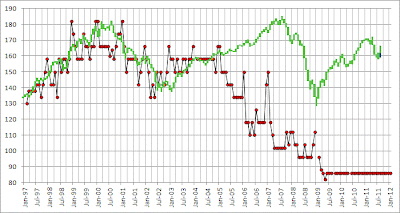I was trying to round up my S&Ts from the many places in my home into which they diffuse, and I was struck by how much their thickness varied over the years. With so many magazines failing or on the ropes, it set me thinking. The only thing to do was to enter the number of pages in each issue into a spreadsheet, right? And once having that done, It was logical to graph the time series. Cue Rod Serling--"Submitted for your consideration:"
 |
| Sky and Telescope Pages per issue, Feb 1997- Jan 2011 |
This shows pages on the vertical axis and time on the horizontal. The dots and black line are for S&T, the green line is the Standard and Poor's 500 index scaled for comparison.
Some observations:
- The general annual pattern is lots of pages in the December and January issues for obvious reason; a minimum in the spring and an uptick for July/August (graduations, Father's Day, it's warm out), another drop in September/October/November
- S&T tracks along with the S&P very well through 2004.
- After 2004 S&T declines rapidly in comparison to the S&P.
- S&T does not recover along with the S&P in 2005-07 nor 2009-11
- S&T dips to 82 pages for one issue in the spring of 2009, then holds constant at 86 pages through January 2012
- The Dec/Jan surge is missing for the holiday seasons of 2009-10,2010-11, 2011-2012
It of looks like S&T is hovering at a size of 86 pages despite a multi-year trend that suggests it should be much smaller at this time. That there were no Holiday surges in the last three years suggests that astro vendors have shifted their advertising bucks elsewhere.
Is the printed version of S&T a lingering relic? Will becoming an e-zine save it? I usually resubscribe in three-year increments, but I think from now on it will be only a year at a time.
Update (January, 2013): The 86-page flatline begun in April 2009 continued another year through the February 2013 issue except for the June issue, in which the page count was only 82. This was matched the record low of May 2009. As you can see from the chart, the spring into summer season has generally had slimmer issues.
The S&P index now stands about 15% above its value during January 2011, so S&T continues to lag in comparison.
Is the printed version of S&T a lingering relic? Will becoming an e-zine save it? I usually resubscribe in three-year increments, but I think from now on it will be only a year at a time.
Update (January, 2013): The 86-page flatline begun in April 2009 continued another year through the February 2013 issue except for the June issue, in which the page count was only 82. This was matched the record low of May 2009. As you can see from the chart, the spring into summer season has generally had slimmer issues.
The S&P index now stands about 15% above its value during January 2011, so S&T continues to lag in comparison.
No comments:
Post a Comment